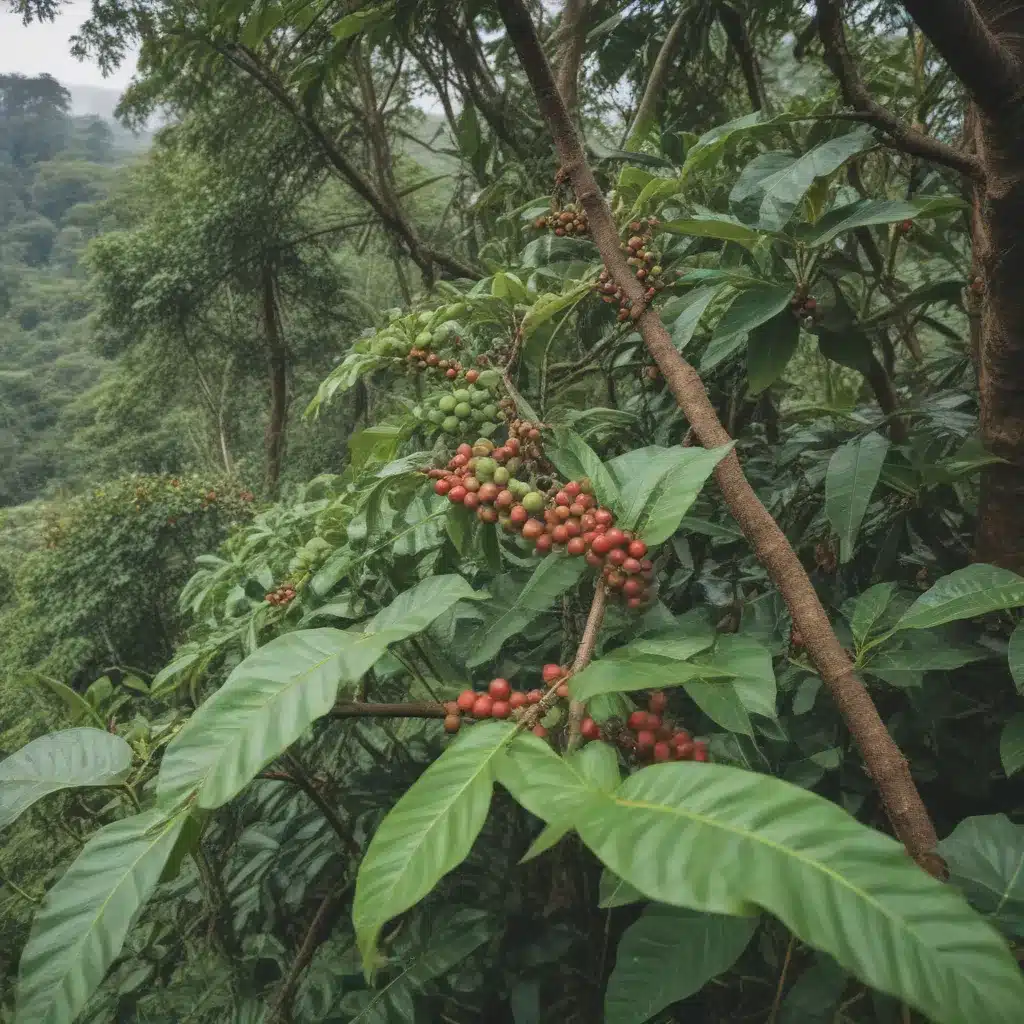
The Bitter-Sweet Truth About Coffee and Nature
Ahhh, the sweet aroma of freshly brewed coffee – is there anything quite like it? As a self-proclaimed coffee connoisseur, I’ve sampled beans from all over the world, each with its own unique flavor profile. But you know what they say, “with great coffee comes great responsibility.”
See, the coffee we sip so blissfully doesn’t just magically appear in our mugs. It’s the result of a complex and often delicate relationship between coffee cultivation and the natural world. And let me tell you, it’s a relationship that’s been the subject of some heated debate (pun intended).
Unraveling the Coffee-Biodiversity Connection
Picture this: you’re strolling through a lush, verdant coffee estate, the plants heavy with ripe, juicy berries. It’s a picturesque scene, right? But scratch the surface, and you’ll find a more nuanced story unfolding.
Recent studies have shed some fascinating light on the impact of coffee cultivation on biodiversity. And the findings might just surprise you. Turns out, the type of coffee grown plays a big role in how it affects the local ecosystem.
At one end of the spectrum, we have “rustic” coffee, where the plants are interspersed with native forest trees and understory. This low-impact approach seems to have the least effect on the local vegetation and bird populations. Then there’s “shade-grown monoculture,” which involves growing coffee plants at higher densities under the forest canopy. This is a bit more intensive, but still far less damaging than the dreaded “sun coffee.”
Sun coffee is the real biodiversity villain here. It involves clearing the forest, removing epiphytic plants from the coffee bushes, and dousing everything in chemical fertilizers. Unsurprisingly, this approach takes a much heavier toll on the local flora and fauna.
But it’s not just the birds that are affected – the impact on other critters like reptiles, butterflies, and mammals has been less thoroughly studied. And let’s not forget about those industrious little insects, the ants. Turns out rustic coffee noticeably reduces ant biodiversity, and it doesn’t get much better no matter how the coffee is grown.
Striking a Balance: Coffee and Sustainability
Okay, so coffee cultivation isn’t exactly a walk in the park when it comes to biodiversity. But does that mean we have to give up our beloved brew? Heck no! We just need to find a way to strike a balance between satisfying our caffeine cravings and protecting the great outdoors.
Enter the Rainforest Alliance – a nonprofit organization that’s been working tirelessly to make the coffee industry more sustainable. They’ve partnered with over 400,000 certified coffee producers, many of them small-scale farmers, covering an estimated 1 million hectares of land.
These farmers are learning cutting-edge, climate-smart growing techniques that not only boost their yields and incomes but also help restore ecosystems and biodiversity. Think things like planting native shade trees, applying fertilizers with precision, and diversifying income streams.
And it’s not just about the farming practices – the Rainforest Alliance is also tackling the human rights side of the equation. They’re working to prevent child labor, forced labor, and discrimination, and ensure that coffee workers enjoy a decent standard of living.
Biodiversity Bounty: A Coffee Estate’s Transformation
Let me tell you about one coffee estate that’s leading the charge in sustainable, biodiversity-friendly farming. It’s the Aquiares Estate Coffee in Costa Rica, and it’s a true eco-warrior’s dream come true.
When the estate started its sustainability journey with the Rainforest Alliance 17 years ago, it was a monoculture, full-sun coffee farm. But fast forward to today, and it’s a veritable biodiversity oasis. They’ve planted over 50,000 native trees, effectively connecting two important wildlife corridors.
And the results speak for themselves – the farm now boasts an impressive 76 different native tree species and 140 bird species, 103 of which had never been seen there before. It’s like a mini-version of the Amazon rainforest, just with a side of perfectly roasted arabica beans.
The Bitter Truth: Coffee’s Fragile Future
But the story doesn’t end there. As much as we’d love to bask in the glory of these biodiversity-boosting coffee estates, the truth is, the future of coffee is far from certain.
Climate change is wreaking havoc on coffee cultivation, with rising temperatures fueling the spread of devastating pests and diseases. And when coffee prices crash due to overproduction, farmers are often forced to switch to more destructive crops, like high-impact ranching or monoculture crops.
It’s a bitter pill to swallow, but it’s a reality we can’t ignore. If we want to enjoy our morning cups of joe for years to come, we need to take action. And that’s where consumers like you and me come in.
Brewing a Brighter Future: The Power of Conscious Consumption
As coffee drinkers, we hold a lot of power in our hands (or mugs, rather). By choosing to support farms and brands that prioritize sustainability and biodiversity, we can make a real difference.
Look for the Rainforest Alliance Certified seal when you’re shopping for your coffee. That way, you’ll know you’re supporting growers who are committed to protecting the environment and the people behind your brew.
And remember, it’s not just about the certification – it’s also about being an informed, conscious consumer. Learn about the different coffee-growing methods and their impact on the local ecosystems. Seek out small-scale, family-run estates that are leading the charge in sustainable, biodiversity-friendly farming.
Together, we can create a future where our coffee addiction doesn’t come at the expense of the natural world. So let’s raise our mugs to a bitter-sweet, biodiversity-rich cup of coffee, shall we?



















